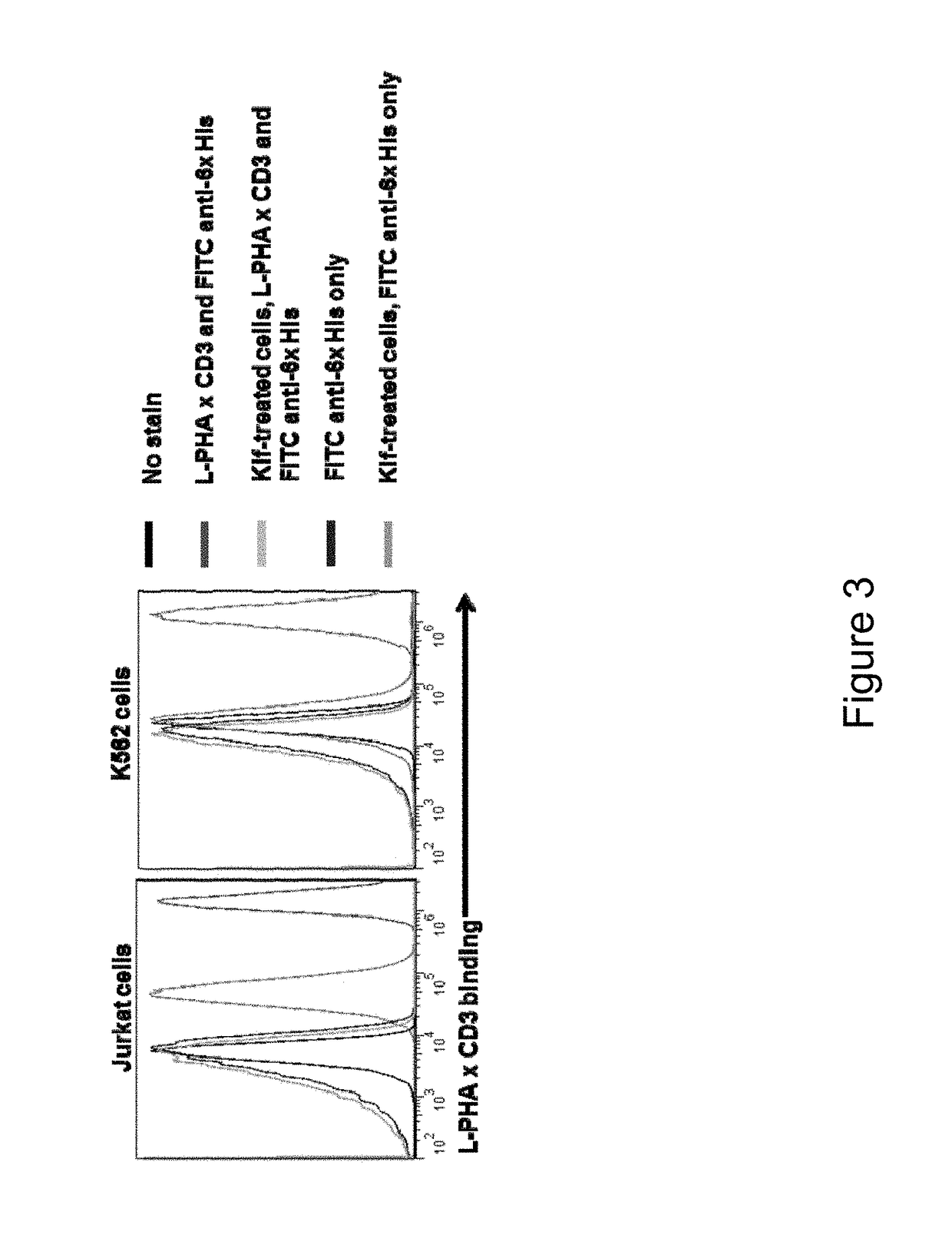Glycan-dependent Immunotherapeutic Molecules
a technology of immunotherapy and glycans, applied in the direction of drug compositions, peptide/protein ingredients, specific cell targeting fusions, etc., can solve the problems of increasing development costs, limiting clinical efficacy, and limiting the number of cancers
- Summary
- Abstract
- Description
- Claims
- Application Information
AI Technical Summary
Benefits of technology
Problems solved by technology
Method used
Image
Examples
experimental examples
[0308]The invention is further described in detail by reference to the following experimental examples. These examples are provided for purposes of illustration only, and are not intended to be limiting unless otherwise specified. Thus, the invention should in no way be construed as being limited to the following examples, but rather, should be construed to encompass any and all variations which become evident as a result of the teaching provided herein.
[0309]Without further description, it is believed that one of ordinary skill in the art can, using the preceding description and the following illustrative examples, make and utilize the present invention and practice the claimed methods. The following working examples therefore, specifically point out the preferred embodiments of the present invention, and are not to be construed as limiting in any way the remainder of the disclosure.
example 1
pendent T Cell Recruiter (GlyTR)
[0310]Malignant transformation of cells is near universally accompanied with aberrant changes of glycosylation on the cell surface (Kim and Varki, 1997, Glycoconj J, 14: 569-576). Indeed, alteration of cell surface glycosylation has been observed in all types of experimental and human cancers (Hakomori, 2002, PNAS USA, 99: 10231-10233), and these altered sugar structures are called tumor-associated carbohydrate antigens (TACAs) (Table 1). This tumor-specific property makes cell surface TACAs an excellent target antigen for production of monoclonal antibodies targeting many common cancers. However, despite decades of effort, specific antibodies with high-affinity against TACAs are not yet available due to difficulties in generating antibodies to carbohydrate antigens.
[0311]One way to address this issue is to utilize lectins, proteins that bind carbohydrates. Evolution has produced hundreds of different carbohydrate-binding proteins that are highly spec...
example 2
d and Nucleotide Sequences
GlyTR L-PHA×CD3
[0319]Leader sequence-L-PHA-Linker-anti-CD3 scFv-His tag
Protein sequence: 525 aa
(SEQ ID NO: 11)MGWSCIILFLVATATGVHSSNDIYFNFQRFNETNLILQRDASVSSSGQLRLTNLNGNGEPRVGSLGRAFYSAPIQIWDNTTGTVASFATSFTFNIQVPNNAGPADGLAFALVPVGSQPKDKGGFLGLFDGSNSNFHTVAVEFDTLYNKDWDPTERHIGIDVNSIRSIKTTRWDFVNGENAEVLITYDSSTNLLVASLVYPSQKTSFIVSDTVDLKSVLPEWVSVGFSATTGINKGNVETNDVLSWSFASKLSDGTTSEGLNLANLVLNKILGGGGSDIKLQQSGAELARPGASVKMSCKTSGYTFTRYTMHWVKQRPGQGLEWIGYINPSRGYTNYNQKFKDKATLTTDKSSSTAYMQLSSLTSEDSAVYYCARYYDDHYCLDYWGQGTTLTVSSVEGGSGGSGGSGGSGGVDDIQLTQSPAIMSASPGEKVTMTCRASSSVSYMNWYQQKSGTSPKRWIYDTSKVASGVPYRFSGSGSGTSYSLTISSMEAEDAATYYCQQWSSNPLTFGAGTKLELKHREIHRH.
Mutated GlyTR L-PHA×CD3, to monomerize the molecule.
Leader sequence-L-PHA(Δ1-5)-Linker anti-CD3 scFv-His tag
Protein sequence: 520 aa
(SEQ ID NO: 12)MGWSCIILFLVATATGVHSFNFQRFNETNLILQRDASVSSSGQLRLTNLNGNGEPRVGSLGRAFYSAPIQIWDNTTGTVASFATSFTFNIQVPNNAGPADGLAFALVPVGSQPKDKGGFLGLFDGSNSNFHTVAVEFDTLYNKDWDPTERHIGIDVNSIRSIKTTRWDFVNGENAEVLITYDSSTNL...
PUM
| Property | Measurement | Unit |
|---|---|---|
| time period | aaaaa | aaaaa |
| time period | aaaaa | aaaaa |
| incubation time period | aaaaa | aaaaa |
Abstract
Description
Claims
Application Information
 Login to View More
Login to View More - R&D
- Intellectual Property
- Life Sciences
- Materials
- Tech Scout
- Unparalleled Data Quality
- Higher Quality Content
- 60% Fewer Hallucinations
Browse by: Latest US Patents, China's latest patents, Technical Efficacy Thesaurus, Application Domain, Technology Topic, Popular Technical Reports.
© 2025 PatSnap. All rights reserved.Legal|Privacy policy|Modern Slavery Act Transparency Statement|Sitemap|About US| Contact US: help@patsnap.com



